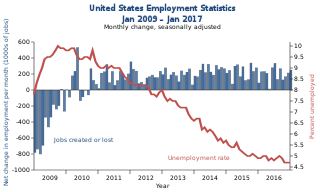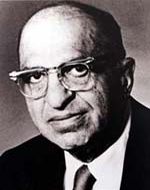Related Research Articles

The Bureau of Labor Statistics (BLS) is a unit of the United States Department of Labor. It is the principal fact-finding agency for the U.S. government in the broad field of labor economics and statistics and serves as a principal agency of the U.S. Federal Statistical System. The BLS collects, processes, analyzes, and disseminates essential statistical data to the American public, the U.S. Congress, other Federal agencies, State and local governments, business, and labor representatives. The BLS also serves as a statistical resource to the United States Department of Labor, and conducts research measuring the income levels families need to maintain a satisfactory quality of life.

A producer price index (PPI) is a price index that measures the average changes in prices received by domestic producers for their output. Formerly known as the wholesale price index between 1902 and 1978, the index is made up of over 16,000 establishments providing approximately 64,000 price quotations that the U.S. Bureau of Labor Statistics (BLS) compiles each month to represent thousands of different goods and services.

Politicians and pundits frequently refer to the ability of the president of the United States to "create jobs" in the U.S. during his term in office. The numbers are most often seen during the election season or in regard to a president's economic legacy. The numbers typically used and most frequently cited by economists are total nonfarm payroll employment numbers as collected by the Bureau of Labor Statistics on a monthly and annual basis. The BLS also provides numbers for private-sector non-farm employment and other subsets of the aggregate.

The Oklahoma Employment Security Commission (OESC) is an independent agency of the state of Oklahoma responsible for providing employment services to the citizens of Oklahoma. The commission is part of a national network of employment service agencies and is funded by money from the United States Department of Labor. The commission is also responsible for administering the Workforce Investment Act of 1998 on behalf of the state.

The United States Consumer Price Index (CPI) is a family of various consumer price indices published monthly by the United States Bureau of Labor Statistics (BLS). The most commonly used indices are the CPI-U and the CPI-W, though many alternative versions exist for different uses. For example, the CPI-U is the most popularly cited measure of consumer inflation in the United States, while the CPI-W is used to index Social Security benefit payments.

The Organisation for Economic Co-operation and Development defines the employment rate as the employment-to-population ratio. This is a statistical ratio that measures the proportion of a country's working age population that is employed. This includes people that have stopped looking for work. The International Labour Organization states that a person is considered employed if they have worked at least 1 hour in "gainful" employment in the most recent week.

The Office of the Under Secretary for Economic Affairs, or OUSEA, is a high-ranking official in the United States Department of Commerce that serves as the principal adviser to the United States Secretary of Commerce on economic analysis.

The International Labor Comparisons Program (ILC) of the U.S. Bureau of Labor Statistics (BLS) adjusts economic statistics to a common conceptual framework in order to make data comparable across countries. Its data can be used to evaluate the economic performance of one country relative to that of other countries and to assess international competitiveness.

Unemployment in the United States discusses the causes and measures of U.S. unemployment and strategies for reducing it. Job creation and unemployment are affected by factors such as economic conditions, global competition, education, automation, and demographics. These factors can affect the number of workers, the duration of unemployment, and wage levels.

Keith Hall served as the Director of the U.S. Congressional Budget Office from 2015 to 2019. He was the Commissioner of the U.S. Bureau of Labor Statistics from January 2008 until January 2012. He previously worked at the Department of Commerce, Department of Treasury, the U.S. International Trade Commission, and the White House Council of Economic Advisers.

Adriana Debora Kugler is an American economist who serves as a member of the Federal Reserve Board of Governors. She previously served as U.S. executive director at the World Bank, nominated by President Joe Biden and confirmed by the U.S. Senate in April 2022. She is a professor of public policy at Georgetown University's McCourt School of Public Policy and is currently on leave from her tenured position at Georgetown. She served as the Chief Economist to U.S. Labor Secretary Hilda L. Solis from September 6, 2011 to January 4, 2013.

Erica Lynn Groshen is the former Commissioner of Labor Statistics and head of the U.S. Bureau of Labor Statistics (BLS), the independent, principal fact-finding agency for the U.S. government in the broad fields of labor economics and statistics, inflation, and productivity. BLS is part of the U.S. Department of Labor.

Isador Lubin was the head of the U.S. Bureau of Labor Statistics from 1933 to 1946, and president of the American Statistical Association in 1946.

Janet Lippe Norwood was an American statistician and the first female Commissioner of the U.S. Bureau of Labor Statistics (BLS) when she was appointed in 1979 by President Jimmy Carter. She was reappointed twice by President Reagan. She left the Bureau in 1991 and joined the Urban Institute as a Senior Fellow, a position she held until 1999. She was also appointed as the Chair of the Advisory Council on Unemployment Compensation, first by President George H. W. Bush in 1993 and then re-elected by President Bill Clinton. She stepped down from that position in 1996. She received numerous awards including several honorary doctorate degrees from academic institutions, including Harvard University.

Katharine G. Abraham is an American economist who is the director of the Maryland Center for Economics and Policy, and a professor of survey methodology and economics at the University of Maryland. She was commissioner of the Bureau of Labor Statistics from 1993–2001 and a member of the Council of Economic Advisers from 2011–2013. She was elected a member of the National Academy of Sciences in 2022.

Aryness Joy Wickens was an American economist and statistician who served as acting commissioner of the US Bureau of Labor Statistics and as president of the American Statistical Association, and who helped develop the United States Consumer Price Index.

Kathleen Utgoff, an American economist, was Commissioner of the Bureau of Labor Statistics from 2002–2006.

William W. Beach is the former Commissioner of Labor Statistics and head of the U.S. Bureau of Labor Statistics (BLS), an independent U.S. government fact-finding agency focused on labor economics and statistics, inflation, and productivity.

Julius Shiskin was an American economist. He is known for his contributions to establishing rules in the field of economic statistics. His 1974 unofficial rule-of-thumb definition of a recession continues to be considered by many as the official definition. He authored two books and numerous articles in the field of statistics, and served as the ninth U.S. Commissioner of the Bureau of Labor Statistics from 1973 until his death.
References
- ↑ "President Biden Announces Key Nominees". The White House. 2023-07-11. Retrieved 2023-07-11.
- ↑ https://www.congress.gov/nomination/118th-congress/837
- ↑ "On the Nomination (Confirmation: Erika L. McEntarfer, of D.C., to be Commissioner of Labor Statistics)". US Senate. January 11, 2024. Retrieved January 11, 2024.
- 1 2 Curriculum Vitae at McEntarfer's personal web site
- ↑ McEntarfer's works listed at Google Scholar
- ↑ McEntarfer's detailed CV with timing
- ↑ Dr. Erika McEntarfer, Commissioner, official page at BLS